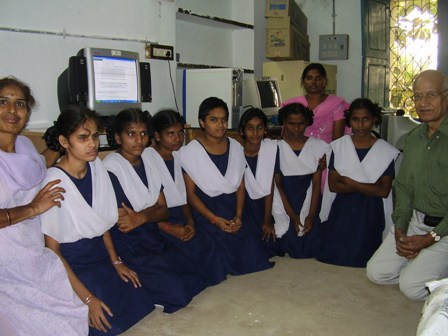This year’s best gift – hope!
What did you feel the first time you saw a computer? You probably marveled at the technology that made it possible for you to send email, learn about what is going on in every corner of the world and a host of other things. The feeling that 10 girls, living in a residential school for the visually impaired, felt when they touched the computer for the first time was similar, and yet different.
As they touched the screen that they could barely see, felt the keyboard that was their ticket to the internet, and ran their fingers over the mouse, the girls were ecstatic. Not having touched a computer before, this was their dream come true. The school these girls were living in was in a secluded village in Southern India. When they expressed their interest in learning how to work with computers, they had no idea their wishes would be fulfilled. There were several hurdles that made this dream almost impossible.
Social hurdles like not being allowed to be taught by a male teacher, geographical hurdles like being far away from a city and economic hurdles like not having funds for such a course, were all overcome by Vision-Aid, a Boston based non-profit organization. Two female teachers were dispatched with equipment and course material to the school to teach an all-costs-covered, on-site course. The computer talks to them and is loaded with special software for the visually challenged. Now, these girls will also be more employable once they complete their education. As for what they can do with the economic freedom that this buys them, the sky is the limit.
What is unfortunate is that there are several states in India that either don’t have rehabilitation centers for the visually impaired, or have centers that consider low-vision people as blind, thereby not providing them with tools or treatment they would benefit from.
Consider the case of Jami, a bright, cheerful 10 year old child born to construction workers. Jami was unable to keep up at school because of his significant low vision. Luckily, Jami was referred to Vision-Aid by an eye hospital. Once he entered the doors of the Vision-Aid center in Vishakapatnam, Jami and his parents have never looked back. With a stand magnifier that helps him read, eye glasses for distant vision and a telescopic aid that helps him see the blackboard at school, Jami is doing well in school and his parents dream of their son receiving a good education and leading a close to normal life, is coming true.
Vision-Aid is unique in their approach to helping the visually impaired. With a board consisting of professionals from a wide range of sectors, from healthcare to IT to financial services, Vision-Aid is applying private sector best practices to achieve their primary goal – rehabilitate as many people as possible.
“Doing it alone is impossible,†says Ram, founder of Vision-Aid. “There are a staggering 90+ million low-vision people in developing countries. For a small organization like ours, that is running 100% on individual contributions, it is difficult to grow as fast and to the size needed. Which is why this year we are focusing on partnerships. In India, most low-vision people come to eye hospitals or centers for the blind. By building partnerships with these centers we can channel the low-vision folks to Vision-Aid, where they will receive appropriate treatment and tools. This is particularly important in the case of children. Early and appropriate intervention can prevent the debilitating effects that vision impairment can cause.
“It is basically a growth-through-partnership strategy,†says Param, Director at Vision-Aid. “While our fund raising activities continue, we are trying to do more with less this year. And partnerships help us do exactly that.â€
The partnership approach seems to be working well – Vision-Aid just signed a partnership with PCB Trust -Jodhpur, an NGO based in Jodhpur, Rajasthan. Through the partnership Vision-Aid will provide, equipment, tools, written materials, expertise and funding to establish a low vision center in Jodhpur. Soon, Western Rajasthan will fall off the list of underserved areas for low vision rehabilitation care.
In the current economic climate where stories of gloom and doom fill the newspapers everyday, it is difficult to remember that even a single dollar can go a long way. But it is contributions from individuals that make it possible for Vision-Aid to help rehabilitate the visually challenged and give them the one gift that they really need – hope.
Please visit the organization at http://www.visionaid.org/donate.html to contribute or to learn more.
